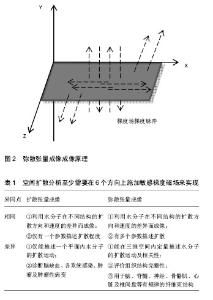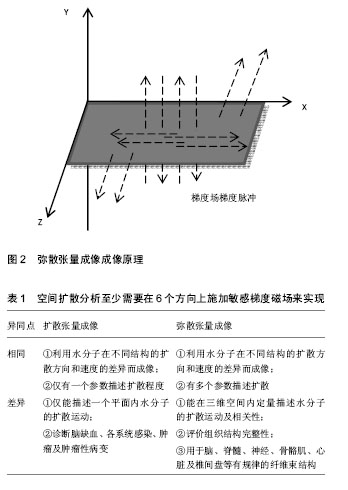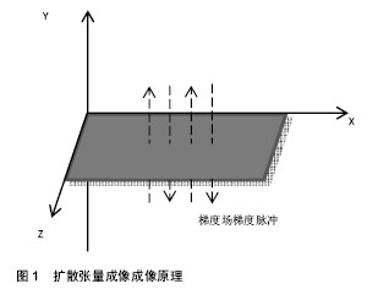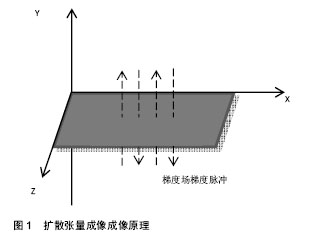Chinese Journal of Tissue Engineering Research ›› 2019, Vol. 23 ›› Issue (8): 1241-1247.doi: 10.3969/j.issn.2095-4344.1086
Previous Articles Next Articles
Advantages and values of magnetic resonance diffusion tensor imaging in clinical diagnosis and treatment
Liu Jianhang1, Liu Hao1, Chen Daoyun2, Xu Zhiwei1, Xie Guixin1, Li Jinwei3
- 1Department of Orthopedic Manipulation, Ruikang Hospital Affiliated to Guangxi University of Chinese Medicine, Nanning 530011, Guangxi Zhuang Autonomous Region, China; 2Department of Orthopedics, Linwu County Hospital of Traditional Chinese Medicine, Chenzhou 424300, Hunan Province, China; 3Yown Kang Tong Chinese Medical Centre, Hong Kong Special Administrative Region 999077, China
-
Online:2019-03-18Published:2019-03-18 -
Contact:Liu Hao, Master candidate, Department of Orthopedic Manipulation, Ruikang Hospital Affiliated to Guangxi University of Chinese Medicine, Nanning 530011, Guangxi Zhuang Autonomous Region, China -
About author:Liu Jianhang, MD, Chief physician, Professor, Department of Orthopedic Manipulation, Ruikang Hospital Affiliated to Guangxi University of Chinese Medicine, Nanning 530011, Guangxi Zhuang Autonomous Region, China -
Supported by:the National Natural Science Foundation of China, No. 81760796 (to CYP); the Program of Guangxi Scientific Research and Technology Development, No. 1598012-34 (to LJH); the Development, Popularization and Application of Appropriate Medical Technology of Guangxi Zhuang Autonomous Region, No. S2017054 (LJH); the Youth Zhiku Research Association, No. GXQNZKA-1702 (to LJH)
CLC Number:
Cite this article
Liu Jianhang, Liu Hao, Chen Daoyun, Xu Zhiwei, Xie Guixin, Li Jinwei. Advantages and values of magnetic resonance diffusion tensor imaging in clinical diagnosis and treatment [J]. Chinese Journal of Tissue Engineering Research, 2019, 23(8): 1241-1247.
share this article

测量扩散程度则通过施加敏感梯度磁场来实现表观弥散系数,反映所施加敏感梯度磁场方向上的水分子扩散程度,用其来衡量水分子在同一平面的扩散运动[4]。在均匀介质中分子的扩散没有受到阻碍,在各个方向上位移是相等的,文章称之为各向同性。但在生物组织中,例如脊髓中,不仅细胞本身如细胞膜、大分子蛋白等使得水分子的扩散受到限制,髓鞘、轴突也会成为限制因素。在具有固定排列顺序的组织结构中,虽然水分子的扩散是随机的,但其更倾向于沿着具有固定排列顺序组织延续的方向弥散,垂直方向较少,文章称其为弥散的各向异性[5]。扩散张量成像只有表观弥散系数一个标量来衡量扩散,只能代表磁场施加方向上的扩散状况,不能够详细、正确的评价分子扩散的各向异性。由于要建立一个三维空间对水分子的扩散进行分析,则需在空间坐标轴X,Y,Z轴的至少6个方向上施加敏感梯度磁场来实现,见图2,而其成像原理在每个方向上与扩散张量成像成像原理相同,见表1。文章用多种参数如各项异性分数、相对各向异性、容积比指数来对空间中水分子的扩散情况进行定量描述,而最常用的则是各项异性分数,指各向异性部分占整个扩散值的比例,变化区间介于0-1。0表示在组织中弥散不受限制,其值越趋向1表示扩散所延方向组织排列越规则、紧密。轴向扩散率表示沿主特征向量方向弥散程度,径向扩散率表示横断面内平均扩散程度。"


弥散张量成像纤维追踪技术是基于弥散张量成像 上的一种新的纤维结构成像技术,其凭借水分子扩散的各向异性特征来追踪纤维的走行,将多个方向走行的纤维束以三维重建的形式组合,可用来观察髓鞘、纤维束的连续性和完整性。 2.2 磁共振弥散张量成像技术在神经系统的应用 2.2.1 弥散张量成像技术在脑中的应用 (1)脑发育与老化:有研究表明大脑的发育、成熟及老化与脑白质体积及结构密切相关,Krogsrud等[6]建立了青春期前儿童白质微观结构变化的区域模型,在弥散张量成像下发现大致上随着时间的推移,脑白质各项异性分数值呈线性增加,径向扩散率下降明显,轴向扩散率略有下降,说明在大脑成长过程中,脑白质结构发生了变化,白质结构排列更为规则、紧密。由此可见,今后弥散张量成像在脑的生长发育以及退化的研究中可以将对脑白质的研究深入到微结构层面。从脑损伤后修复角度来看,脑白质的修复亦是微结构的生长修复。有研究在儿童创伤性脑损伤的研究中提出弥散张量成像可以显示脑白质恢复初期和之后一段时间轨迹的改变,研究损伤后年龄和康复时间因素与神经通路微结构的关联[7]。研究发现与仅有颅骨损伤儿童相比,儿童创伤性脑损伤组在双侧半球所有通路上都具有较低的各项异性分数值,即扩散各向异性受限。年龄较小儿童创伤性脑损伤的起始通路各项异性分数最低,随着时间的推移,各项异性分数的增加幅度最大,表明尽管未完全恢复,但仍持续进行发育修复中。青少年的各项异性分数变化有限,表明修复及发育相对受阻。由此文章可以推测,由于扩散的各向异性,分子扩散常延纤维束走行方向,青少年各项异性分数变化有限,暗示纤维束发育不良并可能会引起创伤后的慢性神经退行性变。再一次说明了脑白质的研究向着微结构方向发展,为文章提供了更多直观的参考依据。 (2)阿尔茨海默病,即“老年痴呆症”,是由中枢神经系统缓慢病变而引起,并且呈现慢性进行性发展的势态。而轻度认知功能障碍是正常状态下神经系统退化、衰老与阿尔茨海默病之间的过渡阶段。然而,从轻度认知功能障碍到阿尔茨海默病的临床转换是不可预测的[8],发现无创性的生物指标,用于检测痴呆早期脑结构变化是一种迫切的需要。 有研究探索将直方图分析应用于弥散张量成像技术检测阿尔茨海默病、轻度认知功能障碍、健康受试者反映各向异性的指标[9],表明脑白质的轴向扩散率可能是阿尔茨海默病病程中脑组织变化的早期参考指标,有助于评估阿尔茨海默病的进展。 之前绝大多数利用弥散张量成像对阿尔茨海默病的探索,都是针对扣带回深部组织扣带束以及海马旁回深部的白质进行研究,利用弥散张量特征参数证明其发病与组织微观结构的不完整性有关[10]。而另有Chitra等[11]及其学术团队则从微结构连通性的角度进一步探究,其利用弥散张量成像技术在胼胝体及扣带回区进行成像并计算,得出了发病时和进展3年的反映结构连通性的参数,即各项异性分数、轴向扩散率、径向扩散率和平均扩散率。结果证明阿尔茨海默病进展的年份中,所有患者的参数值都在下降,而扩散系数每年都在增加,表明疾病发生、发展与胼胝体及扣带回中微结构的连通性降低有相关性。这为利用弥散张量成像技术从微结构连通性角度探讨功能变化提供了案例。 (3)癫痫:近些年,利用弥散张量成像技术对癫痫患者脑结构的研究取得了很大的进展,例如,Wang等[12]通过对比致痫大鼠与非致痫大鼠颞叶内侧弥散张量成像成像各项异性分数的变化,发现高分辨率弥散张量成像可用于颞叶内侧癫痫致痫过程的早期识别和跟踪,通过弥散张量成像识别发现癫痫过程存在于多个脑区,并且其证明了颞叶内侧癫痫中各项异性分数可作为癫痫发生具有时间指示的生物参考指标。Bao等[13]利用弥散张量成像发现同侧扣带回和穹隆的各项异性分数变化与癫痫发作频率相关,而且其还利用弥散张量纤维束成像技术,发现颞叶癫痫患者大脑中的微结构异常,尤其是癫痫侧脑白质和灰质的纤维束有严重损害,而常规MRI和扩散张量成像很难发现这种异常。 (4)精神疾病:在以往的长期研究中,精神分裂症患者的前扣带回的结构完整性已被反复观察到有异常。神经调节蛋白1已被公认为是精神分裂症的候选标记物,其变异可导致少突胶质细胞功能障碍和髓鞘发育不良,因此,可影响精神分裂症患者前扣带回的结构完整性[14-15]。Palaniyappan等[16]研究发现通过把弥散张量成像和磁化转移成像结合起来可以更直观地将精神分裂症患者前扣带回髓鞘含量的异常变化显现出来。 随着弥散张量成像在脑部应用研究的深入,由于神经发育和神经连接被认为在精神分裂症中起关键作用,因此有国外学者将弥散张量成像技术深入到精神分裂症患者大脑微结构连通性的研究上,利用弥散张量成像技术发现早发性精神分裂症患者脑白质显微结构与连通性的变化,从而推断出大脑结构连通性的研究可以为了解精神分裂症的起因和个体发育差异提供更多影像解剖上的证据[17]。 (5)多发性硬化症:多发性硬化症是以脑白质脱髓鞘为病变特点的一种疾病[18],具体表现为如炎性病变、水肿、髓鞘破坏、轴突损伤、胶质细胞增生或综合征等。弥散张量成像技术可以通过各项异性分数显示疾病各相关结构中水分子弥散状态的变化,其中髓鞘含量、轴突计数和胶质细胞增生严重程度在患病和正常脑白质的表现中有显著差异,研究还通过弥散张量纤维束成像追踪发现病变向正常表现白质、灰质的扩散与患者的运动障碍和病程进展有直接联系。 (6)脑肿瘤:弥散张量成像技术为脑肿瘤的识别、定位、鉴别提供了较多的参考依据。例如,弥散张量成像可以区分血管源性水肿和肿瘤浸润性水肿,对肿瘤进行分 级[19-20],区分不同病理类型的肿瘤,以及鉴别肿瘤的分化程度等提供了诸多帮助。而弥散张量纤维束成像技术的应用对于脑白质纤维束的追踪可以清楚显示肿瘤与其周围白质纤维束的解剖关系[20-23],可以对术前规划、术中定位和手术过程提供良好的参考价值。最近的研究更将目光放在从技术方面提高弥散张量纤维束成像的效率上[24-26],有中国学者将弥散张量纤维束成像技术联合神经导航技术使用在临床手术中,对手术入路的选择和规划病灶切除范围有重要的指导意义,其可以最大限度的将肿瘤切除保护正常脑组织,同时还能将神经损伤程度降至最小化。 2.2.2 弥散张量成像技术在脊髓的应用 虽然常规的MRI可以显示脊髓的受压以及信号变化,但弥散张量成像技术作用于脊髓方面,可以更加准确的显示脊髓中的异常变化及损伤情况。因为弥散张量成像技术可以检测到脊髓中弥散系数和各向异性的不规则性,表现为轴向扩散率下降,各项异性分数降低,从而说明轴突死亡、损伤或被破坏(包括创伤、感染、炎症或慢性缺血)会导致沿白质束纵轴扩散运动减弱或中断,而在MRI、扩散张量成像的图像中是无法显示出明显的脊髓损伤迹象的。弥散张量成像技术不仅可以准确的显示受损后脊髓的异常变化,而且可以预测损伤的预后。国外就有学者利用不同的功能测量方 法[27-28],对损伤部位和远离损伤部位的各项异性分数和表观弥散系数值进行相关性分析,预测术后恢复不良和慢性空洞形成[29],这使得弥散张量成像技术为脊髓损伤的诊断以及损伤后康复方面提供了帮助。 2.2.3 弥散张量成像技术在周围神经系统的应用 弥散张量成像技术主要应用于中枢神经系统,由于成像的伪影、周围神经直径较小、水质子密度低等因素的影响,它在周围神经系统中的应用中面临了一定挑战。但随着MRI的升级和技术的进步,使得弥散张量成像技术在周围神经系统的应用成为了可能。 Yamasaki等[30]用弥散张量成像技术的特征参数评价了兔坐骨神经退行性变和再生,比较神经损伤后弥散张量成像参数(各项异性分数、轴向扩散率和径向扩散率)的变化。结果显示,坐骨神经损伤后退行性期各项异性分数降低,径向扩散率升高;相反,在再生阶段,各项异性分数增加,径向扩散率降低。因为各项异性分数改变与轴突数目、髓鞘等修复相关,神经受损后水分子延纤维束方向的扩散减弱,各项异性分数、轴向扩散率降低,径向扩散率增加,神经再生阶段轴突数目、髓鞘进行性恢复,分子扩散的各向异性增加,各项异性分数、轴向扩散率增加,径向扩散率略有降低。清楚地证明了弥散张量成像参数应用于周围神经再生的评价的有效性,也证实了弥散张量成像可作为预测周围神经损伤后恢复程度的有力工具[31]。 这在腰椎间盘突出症患者神经根受压的弥散张量成像中同样得到了体现。国内外学者研究表明,腰椎间盘突出导致受压侧神经根的各项异性分数值降低,各项异性分数降低说明受压侧神经的轴突及髓鞘等受到破坏,各项异性分数越低,神经受损越明显。由此来看,各项异性分数值可以作为腰椎间盘突出症患者神经根受压程度的一个定量参考指标。 近年,弥散张量成像技术在周围神经损伤的研究更加具体化。Heckel等[32]为了证实弥散张量成像参数具有作为腕管正中神经的轴突和髓鞘完整性的生物标志物的潜力,借助电生理学的相关性验证,得出正中神经轴向扩散率与肌肉复合动作电位相关,但与髓鞘完整性无关;径向扩散率与感觉神经传导速度相关,但与轴突完整性无关。所以,大致上轴向扩散率可反映轴突完整性,而径向扩散率可反映髓鞘在同一横截面上的完整性。对于今后在周围神经系统的研究,基于弥散张量成像敏感性,为弥散张量成像技术在症状明显的周围神经病变患者中区分轴突与髓鞘损伤提供了参考依据。 2.3 弥散张量成像技术在脑血管疾病的应用 2.3.1 脑梗死 经过近些年的研究的发展,证明扩散张量成像能准确的检测早期脑梗死,而弥散张量成像技术对梗死后神经纤维束损伤及修复的检测有明显优势。Zhang等[33]用T2加权像和弥散张量成像技术定性、定量评价缺血性脑卒中后脑梗死体积的演变过程。通过弥散张量成像的各项异性分数、表观弥散系数、轴向扩散率和径向扩散率定量评价梗死灶在脑白质(包括胼胝体、外囊和内囊)上的分布。其发现脑卒中后第3天胼胝体内各项异性分数降低,这与轴突损伤、髓鞘损伤或白质纤维损伤的表现相一致。此外,弥散张量成像的各项参数均表明,内囊和外囊均有不同程度的损伤,而脑梗死体积也会在脑卒中后3-30 d逐渐减小,利用弥散张量纤维束成像技术对脑梗死区域进行纤维重建的统计结果表明,缺血性脑卒中后各时间点的平均纤维长度均明显缩短。这使得在缺血性脑梗死发生后,与传统定性分析梗死灶的扩散张量成像技术相比,弥散张量成像可以更加精确的定量评价梗死范围以及梗死灶内纤维结构的异常变化,也为卒中后的康复提供了指导意义。Guo等[34]探讨弥散张量成像在早期诊断锥体束沃勒变性和评估脑梗死后神经功能恢复的作用时发现:利用弥散张量成像发现梗死发生后短时间内同侧锥体束的各项异性分数值下降,符合沃勒变性的表现。之后,同侧锥体束的各项异性分数值变化与美国国立卫生研究院卒中评分量表(NIHSS)内评分指标呈负相关关系,与Barthel指数、运动指数和修正的Rankin评分量表内评分指标呈正相关,进一步说明了弥散张量成像技术可用于早期发现梗死后锥体束沃勒变性信号,并有助于评估梗死后神经功能缺损以及恢复情况。 2.3.2 脑出血 以往弥散张量成像应用于脑出血相关研究相对较少,但也不缺乏研究的优秀案例,例如有国外学者利用弥散张量成像技术获得脑出血患者的结构神经影像和容积比图,勾画出脑出血病灶的空间构型,并通过弥散张量纤维束成像技术对脑出血病灶间的脑白质纤维束进行了识别和可视化[35]。该方法成功地显示了脑出血病变负荷的纵向体积差异以及与主要病灶相交的白质纤维比例随时间的变化情况,而且由于脑出血等神经系统疾病经常表现出相关的病理症状,导致对周围组织施加机械压力,从而导致脑白质纤维的变形、移位,但弥散张量纤维束成像可以避免这种机械压力造成的影响,清楚的显示纤维走行。因此,弥散张量纤维束成像非常适合用于评估脑出血病灶周围脑白质纤维完整性和机械位移情况。 弥散张量成像技术不仅在病灶结构成像上表现突出,还可以对脑出血后患者的意识功能进行评估,由于意识的形成被认为是上行网状激活系统激发产生的,有学者在弥散张量成像成像下做了关于NIHSS和上行网状激活系统定量评估的相关性初步研究,结果证明脑出血后,表示弥散张量成像定量测定的各项异性分数值与NIHSS有较强的相关性,而在上行网状激活系统中各项异性分数值较低的患者更容易失去知觉。这证明了弥散张量成像技术对于上行网状激活系统的各项异性分数值可以用来预测脑出血患者的意识状态。 2.4 磁共振弥散张量成像技术在肌肉系统的应用 弥散张量成像作为一项在神经系统领域应用较为广泛的影像检查技术,在肌肉组织上的临床应用还有待于进一步开发,但理论上利用弥散张量纤维束成像技术可以较好的展现肌肉纤维的连续性[36-38],这使得弥散张量纤维束成像在肌肉系统的研究和应用上大有可开垦之处。肌肉损伤是骨科和运动医学中最常见的创伤之一。损伤后肌肉修复涉及多种复杂过程,如炎症、再生、重塑等阶段。为了发展治疗方式,探讨新型干预剂和新型药物治疗肌肉损伤的疗效,需要建立一种可靠、灵敏的方法来监测肌肉修复过程中肌肉结构和状态的变化。扩散张量成像已广泛应用于组织中水分子扩散的评价,Hata等[37]以小鼠为载体,利用弥散张量成像结合扩散张量成像在研究肌肉修复过程中,发现扩散系数和分子各向异性呈现出明显的动力学特征,其数据显示肌肉修复过程中表观弥散系数、各项异性分数值有明显的改变,说明弥散张量成像可以应用于临床评估肌肉损伤和修复。还有些研究计算了基于弥散张量纤维束成像技术对人体肌肉(包括比目鱼肌、胫前肌、股四头肌、前臂肌群和女性盆底肌群)的特征参数,其可用于预测和研究肌肉的动力学,比如收缩过程中肌肉形变量可以用各向异性的参数来表示。这些研究表明了将功能磁共振成像和其他计算方法以及基于弥散张量成像和弥散张量纤维束成像的肌肉结构信息结合起来所具有的巨大潜力,为今后能够获得对肌肉结构-功能的新见解奠定了基础。 2.5 磁共振弥散张量成像技术在椎间盘的应用 近年来,弥散张量成像技术运用于脊柱的退行性疾病的研究逐渐兴起,虽然常规磁共MRI能很好地识别腰椎间盘退变的形态学改变,但在形态学改变或产生临床症状之前鉴别早期腰椎间盘退变产生的相关微小改变存在一定的困难。因此,近些年弥散张量成像技术被应用于早期腰椎间盘退变的研究上[39-41]。此外,Stadelmann等[39]结合有限元分析数值工具将基于弥散张量成像的信息与椎间盘力学行为的改变联系起来,采用质子密度加权和弥散张量成像序列对人体椎间盘进行高场磁共振成像。对质子密度加权图像进行分割,生成特定的解剖网格,从而形成了椎间盘的圆盘成分和纤维结构。在此模型下,进行张、压、屈、伸、侧弯及旋转等活动,可对椎间盘的体外力学行为进行了定量研究。Shen等[41]通过扩散张量成像、弥散张量成像和T2加权像来检测健康青年人的腰椎间盘,发现同一椎间盘内不同兴趣区间或不同水平面内相应表观弥散系数、各项异性分数值有着明显差异,这就说明水分子在不同水平面的髓核、纤维环等组织中的扩散存在差异,而在髓核区域,不同的兴趣区间在相比之下表观弥散系数越低,则预示着髓核内含水量越低;各项异性分数越高,分子扩散的各向异性增加,则髓核内的原有纤维结构受到破坏。亦有国外学者当把弥散张量纤维束成像技术引入到腰椎间盘退变上时,可以清楚的观察纤维环的完整性,这表明弥散张量成像可以对诊断早期腰椎间盘退变提供有价值的影像学参考,并且有助于进一步研究椎间盘退行性变的病理机制。"

| [1] Oyefiade AA, Ameis S, Lerch JP, et al. Development of short-range white matter in healthy children and adolescents. Human Brain Mapping. 2018;39(1):204-217. [2] Rutman AM, Peterson D J, Cohen W A, et al. Diffusion tensor imaging of the spinal cord: clinical value, investigational applications, and technical limitations. Curr Probl Diagn Radiol. 2018;47(4):257-269. [3] 张涛.磁共振扩散加权与弥散张量成像原理分析及比较[J].现代医用影像学,2017,26(2):369-370.[4] 刘辉,李长勤.磁共振全身弥散加权成像的基本原理及临床应用价值[J].医学影像学杂志,2013,23(7):1126-1129.[5] Koerte IK, Muehlmann M. Diffusion tensor imaging. MRI in Psychiatry. Springer, Berlin, Heidelberg, 2014:77-86. [6] Krogsrud SK, Fjell AM, Tamnes CK, et al. Changes in white matter microstructure in the developing brain-A longitudinal diffusion tensor imaging study of children from 4 to 11 years of age. Neuroimage. 2016;124:473-486. [7] Ewing-Cobbs L, Johnson CP, Juranek J, et al. Longitudinal diffusion tensor imaging after pediatric traumatic brain injury: impact of age at injury and time since injury on pathway integrity. Human Brain Mapping. 2016;37(11):3929-3945. [8] Hoy AR, Ly M, Carlsson CM, et al. Microstructural white matter alterations in preclinical Alzheimer’s disease detected using free water elimination diffusion tensor imaging. PLoS One. 2017;12(3):e0173982. [9] Giulietti G, Serra L, Spanò B, et al. Whole brain white matter histogram analysis of diffusion tensor imaging data detects microstructural damage in mild cognitive impairment and alzheimer's disease patients. J Magn Reson Imaging. 2018;48(3):767-779. [10] Guo Z, Liu X, Hou H, et al. 1H-MRS asymmetry changes in the anterior and posterior cingulate gyrus in patients with mild cognitive impairment and mild Alzheimer's disease. Compr Psychiatry. 2016;69:179-185. [11] Chitra R, Bairavi K, Vinisha V, et al. Analysis of structural connectivity on progression of Alzheimer's disease using diffusion tensor imaging. Signal Processing, Communication and Networking (ICSCN), 2017 Fourth International Conference on. IEEE. 2017:1-5. [12] Wang H, Huang Y, Coman D, et al. Network evolution in mesial temporal lobe epilepsy revealed by diffusion tensor imaging. Epilepsia. 2017;58(5):824-834. [13] Bao Y, He R, Zeng Q, et al. Investigation of microstructural abnormalities in white and gray matter around hippocampus with diffusion tensor imaging (DTI) in temporal lobe epilepsy (TLE). Epilepsy Behav. 2018;83:44-49. [14] Nucifora LG, Tanaka T, Hayes LN, et al. Reduction of plasma glutathione in psychosis associated with schizophrenia and bipolar disorder in translational psychiatry. Transl Psychiatry. 2017;7(8): e1215. [15] Schneider S, Götz K, Birchmeier C, et al. Neuregulin-1 mutant mice indicate motor and sensory deficits, indeed few references for schizophrenia endophenotype model. Behav Brain Res. 2017;322: 177-185. [16] Palaniyappan L, Radaideh A, Mougin O, et al. T167. Aberrant myelination of the cingulum bundle in patients with schizophrenia: a 7t mti/dti study. Schizophr Bull. 2018;44(Suppl 1):S180. [17] Tamnes CK, Agartz I. White matter microstructure in early-onset schizophrenia: a systematic review of diffusion tensor imaging studies. J Am Acad Child Adolesc Psychiatry. 2016;55(4):269-279. [18] Fatehi D, Naleini F, Gharib Salehi M. Evaluation of multiple sclerosis patients through structural biomarkers of diffusion tensor magnetic imaging and correlation with clinical features. J Chem Pharm Sci. 2016;9(2):830-837. [19] Hempel JM, Schittenhelm J, Bisdas S, et al. In vivo assessment of tumor heterogeneity in WHO 2016 glioma grades using diffusion kurtosis imaging: diagnostic performance and improvement of feasibility in routine clinical practice. J Neuroradiol. 2018;45(1):32-40. [20] Choi YS, Ahn SS, Lee SK, et al. Amide proton transfer imaging to discriminate between low-and high-grade gliomas: added value to apparent diffusion coefficient and relative cerebral blood volume. Eur Radiol. 2017;27(8):3181-3189. [21] 姜亮,殷信道.磁共振功能成像在脑肿瘤诊断中的应用价值[J].中国CT和MRI杂志,2015,13(1):112-115.[22] Iv M, Yoon BC, Heit JJ, et al. Current clinical state of advanced magnetic resonance imaging for brain tumor diagnosis and follow up. semin roentgenol. 2018;53(1):45-61. [23] Dubey A, Kataria R, Sinha VD. Role of diffusion tensor imaging in brain tumor surgery. Asian J Neurosurg. 2018;13(2):302. [24] Oda K, Yamaguchi F, Enomoto H, et al. Prediction of recovery from supplementary motor area syndrome after brain tumor surgery: preoperative diffusion tensor tractography analysis and postoperative neurological clinical course. Neurosurg Focus. 2018;44(6):E3. [25] Savardekar AR, Patra DP, Thakur JD, et al. Preoperative diffusion tensor imaging–fiber tracking for facial nerve identification in vestibular schwannoma: a systematic review on its evolution and current status with a pooled data analysis of surgical concordance rates. Neurosurg Focus. 2018;44(3):E5. [26] 胡先超,张少军,韩易,等.DTT成像联合神经导航在脑功能区肿瘤手术中的应用[J].中国微侵袭神经外科杂志,2017,22(3):119-122.[27] Okita G, Ohba T, Takamura T, et al. Application of neurite orientation dispersion and density imaging or diffusion tensor imaging to quantify the severity of cervical spondylotic myelopathy and to assess postoperative neurologic recovery. Spine J. 2018;18(2):268-275. [28] Rajasekaran S, Kanna RM, Chittode VS, et al. Efficacy of diffusion tensor imaging indices in assessing postoperative neural recovery in cervical spondylotic myelopathy. Spine. 2017;42(1):8-13. [29] Rindler RS, Chokshi FH, Malcolm JG, et al. Spinal diffusion tensor imaging in evaluation of preoperative and postoperative severity of cervical spondylotic myelopathy: systematic review of literature. World Neurosurg. 2017;99:150-158. [30] Yamasaki T, Fujiwara H, Oda R, et al. In vivo evaluation of rabbit sciatic nerve regeneration with diffusion tensor imaging (DTI): correlations with histology and behavior. Magn Reson Imaging. 2015; 33(1):95-101. [31] 崔婷婷,李松柏.腰椎间盘突出症患者受压神经根DTI与临床表现的相关性[J].中国医学影像术,2017,33(12):1869-1873.[32] Heckel A, Weiler M, Xia A, et al. Peripheral nerve diffusion tensor imaging: assessment of axon and myelin sheath integrity. PLoS One. 2015;10(6):e0130833. [33] Zhang J, Zhao H, Wang W, et al. GW28-e1057 Study on white matter injury after ischemic stroke evaluated by diffusion tensor imaging. J Am College Cardiol. 2017;70(16 Supplement):C176-C177. [34] Guo AH, Hao FL, Liu LF, et al. An assessment of the correlation between early postinfarction pyramidal tract Wallerian degeneration and nerve function recovery using diffusion tensor imaging. Genet Mol Res. 2017;16(1). doi: 10.4238/gmr16019035. [35] Goh SYM, Irimia A, Torgerson CM, et al. Longitudinal quantification and visualization of intracerebral haemorrhage using multimodal magnetic resonance and diffusion tensor imaging. Brain Injury. 2015;29(4):438-445. [36] Pashakhanloo F, Herzka D A, Ashikaga H, et al. Myofiber architecture of the human atria as revealed by submillimeter diffusion tensor imaging. Circulation. 2016;9(4):e004133. [37] Hata J, Mizuno S, Haga Y, et al. Semiquantitative evaluation of muscle repair by diffusion tensor imaging in mice. JBMR Plus. 2018;2(4):227-234. [38] amon BM, Froeling M, Buck AKW, et al. Skeletal muscle diffusion tensor-MRI fiber tracking: rationale, data acquisition and analysis methods, applications and future directions. NMR in Biomed. 2017; 30(3):e3563. [39] Stadelmann M A, Maquer G, Voumard B, et al. Integrating MRI-based geometry, composition and fiber architecture in a finite element model of the human intervertebral disc. J Mech Behav Biomed Mater. 2018; 85:37-42. [40] Wáng YXJ, Belavý DL, Vergroesen PPA, et al. On magnetic resonance imaging of intervertebral disc aging/authors' reply to wang: " on magnetic resonance imaging of intervertebral disc ageing". Sports Med. 2017;47(1):187. [41] Shen S, Wang H, Zhang J, et al. Diffusion weighted imaging, diffusion tensor imaging, and T2* mapping of lumbar intervertebral disc in young healthy adults. Iran J Radiol. 2016;13(1):e30069. |
| [1] | Min Youjiang, Yao Haihua, Sun Jie, Zhou Xuan, Yu Hang, Sun Qianpu, Hong Ensi. Effect of “three-tong acupuncture” on brain function of patients with spinal cord injury based on magnetic resonance technology [J]. Chinese Journal of Tissue Engineering Research, 2021, 25(在线): 1-8. |
| [2] | Zhang Tongtong, Wang Zhonghua, Wen Jie, Song Yuxin, Liu Lin. Application of three-dimensional printing model in surgical resection and reconstruction of cervical tumor [J]. Chinese Journal of Tissue Engineering Research, 2021, 25(9): 1335-1339. |
| [3] | Jiang Hongying, Zhu Liang, Yu Xi, Huang Jing, Xiang Xiaona, Lan Zhengyan, He Hongchen. Effect of platelet-rich plasma on pressure ulcers after spinal cord injury [J]. Chinese Journal of Tissue Engineering Research, 2021, 25(8): 1149-1153. |
| [4] | Chai Le, Lü Jianlan, Hu Jintao, Hu Huahui, Xu Qingjun, Yu Jinwei, Quan Renfu. Signal pathway variation after induction of inflammatory response in rats with acute spinal cord injury [J]. Chinese Journal of Tissue Engineering Research, 2021, 25(8): 1218-1223. |
| [5] | Wan Ran, Shi Xu, Liu Jingsong, Wang Yansong. Research progress in the treatment of spinal cord injury with mesenchymal stem cell secretome [J]. Chinese Journal of Tissue Engineering Research, 2021, 25(7): 1088-1095. |
| [6] | Zeng Yanhua, Hao Yanlei. In vitro culture and purification of Schwann cells: a systematic review [J]. Chinese Journal of Tissue Engineering Research, 2021, 25(7): 1135-1141. |
| [7] | Kong Desheng, He Jingjing, Feng Baofeng, Guo Ruiyun, Asiamah Ernest Amponsah, Lü Fei, Zhang Shuhan, Zhang Xiaolin, Ma Jun, Cui Huixian. Efficacy of mesenchymal stem cells in the spinal cord injury of large animal models: a meta-analysis [J]. Chinese Journal of Tissue Engineering Research, 2021, 25(7): 1142-1148. |
| [8] | Xie Yang, Zhang Shujiang, Liu Menglan, Luo Ying, Yang Yang, Li Zuoxiao. Mechanism by which rapamycin protects spinal cord neurons in experimental autoimmune encephalomyelitis mice [J]. Chinese Journal of Tissue Engineering Research, 2021, 25(5): 695-700. |
| [9] | Ma Binxiang, He Wanqing, Zhou Guangchao, Guan Yonglin. Triptolide improves motor dysfunction in rats following spinal cord injury [J]. Chinese Journal of Tissue Engineering Research, 2021, 25(5): 701-706. |
| [10] | Luo Xuanxiang, Jing Li, Pan Bin, Feng Hu. Effect of mecobalamine combined with mouse nerve growth factor on nerve function recovery after cervical spondylotic myelopathy surgery [J]. Chinese Journal of Tissue Engineering Research, 2021, 25(5): 719-722. |
| [11] | Xu Dongzi, Zhang Ting, Ouyang Zhaolian. The global competitive situation of cardiac tissue engineering based on patent analysis [J]. Chinese Journal of Tissue Engineering Research, 2021, 25(5): 807-812. |
| [12] | Wu Zijian, Hu Zhaoduan, Xie Youqiong, Wang Feng, Li Jia, Li Bocun, Cai Guowei, Peng Rui. Three-dimensional printing technology and bone tissue engineering research: literature metrology and visual analysis of research hotspots [J]. Chinese Journal of Tissue Engineering Research, 2021, 25(4): 564-569. |
| [13] | Chang Wenliao, Zhao Jie, Sun Xiaoliang, Wang Kun, Wu Guofeng, Zhou Jian, Li Shuxiang, Sun Han. Material selection, theoretical design and biomimetic function of artificial periosteum [J]. Chinese Journal of Tissue Engineering Research, 2021, 25(4): 600-606. |
| [14] | Liu Fei, Cui Yutao, Liu He. Advantages and problems of local antibiotic delivery system in the treatment of osteomyelitis [J]. Chinese Journal of Tissue Engineering Research, 2021, 25(4): 614-620. |
| [15] | Li Xiaozhuang, Duan Hao, Wang Weizhou, Tang Zhihong, Wang Yanghao, He Fei. Application of bone tissue engineering materials in the treatment of bone defect diseases in vivo [J]. Chinese Journal of Tissue Engineering Research, 2021, 25(4): 626-631. |
| Viewed | ||||||
|
Full text |
|
|||||
|
Abstract |
|
|||||

